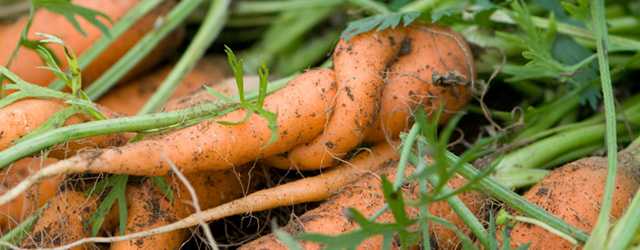- Carrot Growing Guide | Fundamentals of Bed Preparation, Spacing, Weeding & Watering - Part 1
- Carrot Growing Guide | Season Extension to Lengthen Your Carrot Harvest - Part 2
- Carrot Harvesting, Handling & Storage | Carrot Growing Guide
- Carrot Growing Guide | Common Carrot Pests & Diseases - Part 4
- Colored Carrot Varieties | Visual Comparison Chart (PDF)
- Carrots | Key Growing Information
- Early, Main Crop & Storage Carrot Varieties | Photo Comparison Chart (PDF)
- Pelleted Carrots | Key Growing Information
- Video: How to Grow Carrots • From Seed to Harvest
- Video: 'Glow Stix Sunrise Mix' Carrots | Exclusively from Johnny's Selected Seeds
- Classic Storage Crops | Post-Harvest Handling & Storage Guidelines
- Winter Growing | Recommended Crops & Varieties
- Webinar Slide Deck | Flower Seed Starting Fundamentals | PDF
- Choosing Carrots: A Guide to Varieties You Will Dig
- Webinar Slide Deck | Choosing Carrots: A Guide to Varieties You Will Dig | PDF
- Choosing Carrots: A Guide to Varieties You Will Dig
Prevention Is Key
First and foremost, adhering to Best-Practices for Carrot Culture is the ounce of prevention that puts you ahead of disease pressure. Second, because inadvertent damage to roots, whether incurred mechanically or by pests, can often lead to secondary infections, it's wise to scout frequently, so you can apply the pound of cure before it spreads.
Still, there is always the possibility that your carrot planting will be afflicted by any one of a number of carrot pathogens. A comprehensive look at carrot pathogens is beyond the scope of this article, but it's important to have familiarity with the pathogens that are most likely to become an issue.
The next step is proper diagnosis of a carrot disease — before you implement a management strategy. For assistance with this, turn to your local cooperative extension agency, agricultural university, or ministries of agriculture, which are staffed by experts the grower can call upon for assistance in identification and management, should the need arise.
Here is a overview of the more common carrot pests and diseases.
Carrot Diseases
Several leaf blights can reduce the yield and quality of a carrot crop. Common carrot leaf blights include:
Alternaria blight (Alternaria dauci)
Appearance: Brown-black lesions edged with yellow on leaf margins, beginning on the oldest leaves.
Alternaria blight often causes leaflets to curl, become dry, and eventually die. At later stages, petioles may become infected. If leaves are infected early enough, roots may never fully mature.
To help reduce risk of occurrence, as well as reduce spread of infection:
- Choose varieties with some amount of resistance.
- Reduce water on leaves by either watering in the morning or by employing drip irrigation.
- Strive for proper plant densities and do not overcrowd rows.
- Avoid applying excessive nitrogen, as this can lead to overabundant leaves and reduced air flow around the tops.
Alternaria blight-resistant carrot varieties…
Cercospora blight (Cercospora carotae)
Appearance: First appears as small, dark spots with yellow margins, on younger leaves and stems.
See Alternaria for recommendations on how to reduce issues.
Carrot Pests
Carrot Rust Fly (Psila rosae)
Typical of many pests, the carrot rust fly is not an issue everywhere. Problems seem to be more prevalent in temperate regions. Fly larvae are problematic because they burrow into carrot roots, rendering them unmarketable.
The best methods for control include:
- Maintaining a 3–5-year crop rotation of all crops within the carrot family (Apiaceae), and locating these crops as far away as possible from the previous year's crop. (Some other crops within the family Apiaceae include parsnips, celery, parsley, dill, chervil, fennel, and cilantro.)
- Row cover is another method of exclusion. Covers should be placed over beds once the seeds germinate, and the edges should be buried in order to be effective.
Wire Worms (Elateridae, Click Beetle Family)
Wireworms are the larvae of click beetles. They can be detrimental to a carrot crop as they burrow into the roots, drilling holes that make them unmarketable.
The best methods for reducing problems with wireworms are:
- Crop rotation (rotating with non-host species).
- Avoid planting carrots in any location that was recently in sod.
- Fall plowing, to expose wireworms to predators such as birds.
Prevention & Early Identification
Whatever and wherever you grow, follow best practices and make scouting a matter of routine. These are the keystones to keeping your crops healthy, and carrots are no exception.
If you suspect that a carrot disease or pest is becoming a problem for you, establish contact with your regional cooperative extension agency or ministry of agriculture as soon as possible. The experts at these agencies can assist you with up-to-date knowledge on the proper identification of carrot root pests and pathogens, as well as the best options for management in your area, so they do not become a recurrent issue for you.
Further Reading
- Next up in our carrot-growing series:
- Fundamentals of Carrot Culture: Bed Prep, Spacing, Weeding & Watering • Article
- Season Extension: How to Expand Your Carrot Harvest Window • Article
- Carrot Harvesting, Post-Harvest Handling & Storage Tips • Article
- More resources:


